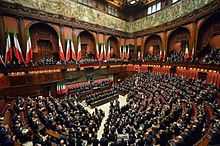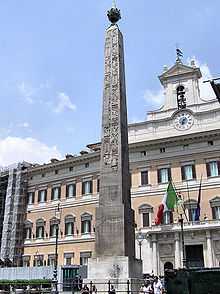Chamber of Deputies (Italy)
| Chamber of Deputies Camera dei Deputati | |
|---|---|
 | |
| Type | |
| Type |
Lower house of the Parliament of Italy |
| Leadership | |
President of the Chamber | |
| Structure | |
| Seats | 630 |
 | |
Political groups |
Government (409)
Opposition Parties (221) |
| Elections | |
| Semi-proportional representation | |
Last election | 24–25 February 2013 |
Next election | 2018 or earlier |
| Meeting place | |
 | |
| Palazzo Montecitorio, Rome | |
| Website | |
|
http://en.camera.it/ and http://www.camera.it/leg17/46 | |
The Chamber of Deputies (Italian: Camera dei Deputati) is a house of the bicameral Parliament of Italy (the other being the Senate of the Republic). The two houses together form a perfect bicameral system, meaning they perform identical functions, but do so separately. Pursuant to article 56 of the Italian Constitution, the Chamber of Deputies has 630 seats, of which 618 are elected from Italian constituencies, and 12 from Italian citizens living abroad. Deputies meet in the Palazzo Montecitorio. The Chamber and the parliamentary system of the Italian Republic and under the previous Kingdom of Italy is a continuation of the traditions and procedures of the Parliament and Chamber of Deputies as established under King Charles Albert, (1798-1849), during the Revolutions of 1848, and his son Victor Emmanuel II, (1820-1878) of the Kingdom of Sardinia-Piedmont which led in the "Italian unification 'Risorgimento' movement" of the 1850s and '60s, under the leadership of then Prime Minister, Count Camillo Benso of Cavour ("Count Cavour"), [1810-1861].
The Seat
The seat of the Chamber of Deputies is the Palazzo Montecitorio, where it has met since 1871, shortly after the capital of the Kingdom of Italy was moved to Rome at the successful conclusion of the Italian unification Risorgimento movement.
Previously, the seat of the Chamber of Deputies of the Kingdom of Italy had been briefly at the Palazzo Carignano in Turin (1861–1865) and the Palazzo Vecchio in Florence (1865–1871). Under the Fascist regime of Benito Mussolini, from 1939 to 1943, (during World War II), the Chamber of Deputies was abolished and replaced by the figurehead Chamber of Fasci and Corporations.
The Electoral System
Current system
The election of members to the Chamber of Deputies is by voluntary, universal, direct suffrage by all citizens of age on election day. Terms last for a total of five years, unless an early dissolution of the Chamber is called by the President of the Republic (e.g. as a result of parliamentary deadlock), at which point a snap election is held. Unlike the Senate, which requires members to be 40 years of age, members of the Chamber of Deputies may be elected at 25.[1]
Under current law, members of the Chamber of Deputies are elected through a party-list proportional system. They are eligible for the allocation of seats based on three criteria: first, they are eligible for seats if the coalition to which their party belongs has reached a minimum of 10% of total valid votes. Within the coalition, the party must also have 2% of total, valid votes to garner seats. Beside these two criteria, it is also possible to participate in the allocation of seats if a party does not belong to a coalition but still receives 4% of total, valid votes.
Article 61 of the Italian Constitution maintains that elections for the Chamber of Deputies must take place within 70 days of the dissolution of house, and that representatives must convene within 20 days of those elections.
Normal operation of the assembly
The Chamber is composed of all members meeting in session at the Montecitorio. The assembly also has the right to attend meetings of the Government and its ministers. If required, the Government is obligated to attend the session. Conversely, the Government has the right to be heard every time it requires.
The term of office of the House (as well as the Senate) is five years, but can be extended in two cases:
- The "prorogatio", as provided by art. 61.2 of the Constitution, states that representatives whose term has expired shall continue to exercise their functions until the first meeting of the new Chamber.
- An extension of the term, provided for by art. 60.2, can be enacted only in case of war.
The Speaker
The Speaker of Chamber of Deputies (officially called Presidente della Camera dei Deputati) is elected during the first session after the election. During this time the prerogatives of speaker are assumed by the vicepresident of Chamber of Deputies[2] during the previous legislature who was elected deputy before. If there aren't, the oldest deputy serves as president of Chamber of Deputies.
The President of Chamber of Deputies has also the role of President during the Parliament joint sessions, when the upper and lower houses have to vote together.
Membership
The box below summarizes the distribution of seats in the Italian Chamber of Deputies, following the latest political elections on 24–25 February 2013:
| Coalition | Party | Seats | Seats (%) | Popular Vote (%) | ||
|---|---|---|---|---|---|---|
| Pier Luigi Bersani: Italy. Common Good |
Democratic Party (PD) | 297 | 47.1 | 25.4 | ||
| Left Ecology Freedom (SEL) | 37 | 5.9 | 3.2 | |||
| Democratic Centre (CD) | 6 | 0.95 | 0.49 | |||
| South Tyrolean People's Party (SVP) | 5 | 0.79 | 0.49 | |||
| Total | 345 | 54.8 | 29.5 | |||
| Silvio Berlusconi: Centre-right coalition |
The People of Freedom (PdL) | 98 | 15.6 | 21.56 | ||
| Lega Nord (LN) | 18 | 2.86 | 4.08 | |||
| Brothers of Italy (FdI) | 9 | 1.43 | 1.95 | |||
| Total | 125 | 19.84 | 29.1 | |||
| Beppe Grillo: Five Star Movement (M5S) | 109 | 17.3 | 25.5 | |||
| Mario Monti: With Monti for Italy |
Civic Choice (SC) | 37[lower-alpha 1] | ||||
| Union of the Centre (UDC) | 8 | 1.27 | 1.78 | |||
| With Monti for Italy (SC abroad) | 2 | |||||
| Total | 47 | 7.46 | 10.56 | |||
| Associative Movement Italians Abroad (MAIE) | 2 | |||||
| Unione Sudamericana Emigrati Italiani (USEI) | 1 | |||||
| Aosta Valley (VdA) | Edelweiss (SA) | 1 | ||||
| Total | 630 | 100 | 100 | |||
- Notes
- ↑ Incl. the Union for Trentino (UPT) party leader Lorenzo Dellai, who decided not to submit his own party list for the Monti-coalition, but opted to be a direct part of the Civic Choice list.[3][4]
As illustrated by the bars above, the Bersani-led coalition won the plurality in the nationwide election with a 0.4% lead over the nearest coalition, and thus - as defined by the Italian election law - was granted a majority bonus equal to an automatic 55% of the seats in the Chamber of Deputies.
See also
References
- ↑ http://en.camera.it/4?scheda_informazioni=3
- ↑ There are four vicepresidents who lead the debate when there is not the President of the chamber.
- ↑ "List Monti in Trentino: Lorenzo Dellai and candidates from Societa' Civile" (in Italian). l'Adige. 9 January 2013. Retrieved 28 February 2013.
- ↑ "Regional elections, the idea of coalition wins" (in Italian). l'Adige. 26 February 2013. Retrieved 28 February 2013.
External links
-

Obelisk of Montecitorio. In the background is the Italian Chamber of Deputies
-

Back side of Palazzo Montecitorio designed by architect Ernesto Basile.
-
Front side of Palazzo Montecitorio.
-

Another photo of the main entrance of Montecitorio with the Montecitorio column.
| ||||||||||||||||||||||||||||||||||||||||||||
| ||||||||||||||||||||||
